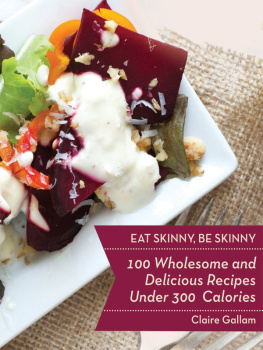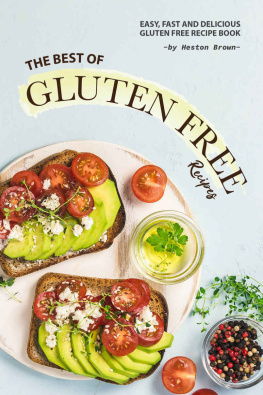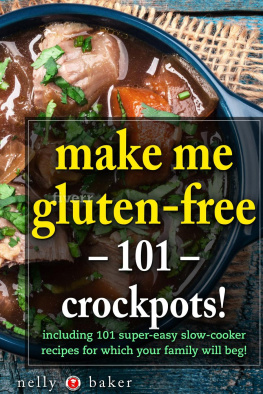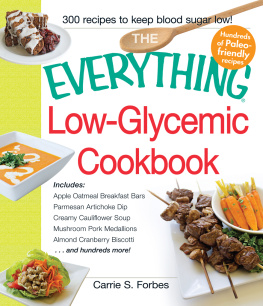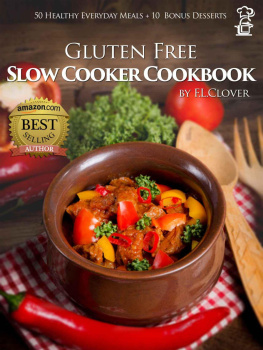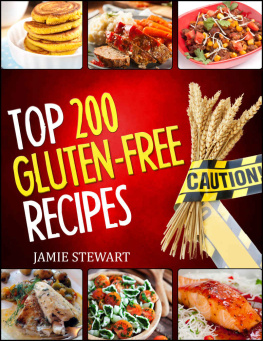THE

WEEKNIGHT
GLUTEN-FREE
COOKBOOK
Claire Gallam

Avon, Massachusetts
Contents
Introduction
A FEW YEARS AGO, a gluten allergy or celiac disease diagnosis meant one thing: Youd no longer be able to eat the foods you once loved. You had to say goodbye to pizza nights with your roommates, happy-hour beers with your coworkers, and birthday cakes with your family. The foods you grew up eating, the ones you looked forward to as a kid, were now completely off-limits. The only gluten-free options in supermarkets and restaurants were either overpriced or unappetizing. Living gluten-free meant drastically changing your life, and food became more of a necessity rather than something you enjoyed.
However, due to an increase in diagnoses of celiac disease and gluten intolerance and new scientific research, a gluten-free diet is not as deprived and bland as it once was. Large food brands, popular chefs, top restaurants, and food writers are coming up with good-tasting and easy gluten-free mixes, dishes, and recipes. People suffering from a gluten allergy are now welcomed with aisles of food to choose from in most supermarkets, and at many restaurants youll find an entire menu of gluten-free choices.
However, the cost of these products is still much higher than their counterparts. For example, a package of high-quality, gluten-free frozen pizzas can cost up to three times the amount of regular frozen pizzas. Gluten-free baking mixes are also at least $1$1.50 more per box than standard cake, cookie, or brownie mixes. At some restaurants, a gluten-free sub for pasta or bread can set you back more than $5 more as well. There may be more options, but the high cost of these options can be a huge financial strain for families and people on a tight budget.
So instead of spending double on takeout pizza or a sub at the local deli on those busy weeknights, why not save your pennies and make something even better at home? Here, youll find hundreds of easy-to-make, lower-cost, gluten-free dishes that taste amazing and can be made after a long day at work or school. There are recipes that appeal to every important person in your life, from your meat-loving husband to your picky kids to your vegan friends, and everyone in between.
The recipes arent overly difficult or complicated. In fact, all of these recipes were developed for beginning and intermediate cooks. Besides being easy, recipes in this collection are substantially more economical than store-bought or takeout items. Most of the ingredients can be purchased at your local supermarket. Dishes are comprised of mostly fresh fruits, vegetables, meat, poultry, dairy, and healthy fats. A few recipes call for gluten-free flours or blends. See for information on choosing gluten-free flours for cooking and baking from scratch. Also, the nutritional information is listed for each recipe, which will make it even easier to stay in shape and pursue a healthy, gluten-free lifestyle.
Life is busy enough, and dinner should be the last thing you stress about. And with the recipes in this book, cooking a healthy, home-cooked meal doesnt mean youll be spending hours in the kitchen. Make a plan on the weekend and follow these simple, easy-to-pull-together recipes for the busy nights during the week. A healthy dinner on the table doesnt have to take longer than 45 minutes. Some recipes are for hands-off, slow cooker meals that you can start in the morning and forget about until you get hometo the lovely aroma of dinner thats ready to eat!
Enjoy!
CHAPTER 1
Living Gluten-Free
Due to the increase in awareness of celiac disease and gluten intolerance, there is more information than ever available for those who are recently diagnosed. However, even with the abundance of information out there, you may still struggle with understanding what your new gluten-free diet entails and how you can make it work in your busy life. Here youll find information about gluten and gluten intolerance, along with tips for making the transition to the gluten-free lifestyle as seamless as possible. Youll see how easy it can be to create tasty and nutritious weeknight dinners, without spending all your time in the kitchen.
Gluten Defined
Gluten is the term used for several types of proteins found in wheat, barley, and rye. The proteins gliadin and glutelin are found in these grains and together form a substance called gluten. Gluten is a storage protein, which means that it holds the key ingredients for these grains to continue proliferating.
Gluten is primarily found in foods like bread, pasta, cakes, muffins, crackers, and pizza dough. Wheat, barley, and rye are used in many baked goods because the gluten in these grains provides excellent elasticity, structure, and texture. Gluten is what causes pizza to have a chewy, stretchy texture. It gives French bread its soft, white center and chewy crust. Gluten makes cinnamon rolls stretchy, soft, and light. It helps give structure to bread dough when rising, so that the bread becomes tall and stays tall after baking and cooling.
Avoiding gluten can be difficult for several reasons. The biggest reason is that ingredients containing gluten are not required by law to be listed on food labels. However, by law, the top eight food allergens must be listed on every food label in the United States, and wheat (which is a primary source of gluten) is one of them. So although you may not see gluten in the ingredients list, you can look for food allergen information, for example, contains wheat.
When you are removing gluten from your diet, you will also need to avoid these foods (most are derivatives of wheat), which also contain gluten:
- Barley
- Bulgur
- Couscous
- Durum flour
- Farina
- Graham flour
- Kamut
- Rye
- Semolina
- Spelt
- Triticale (a cross between rye and wheat)
As a matter of fact, its often a good idea (especially when you first receive a diagnosis of celiac disease) to only eat foods that are either naturally gluten-free or actually are labeled gluten-free until you have a better understanding of how to read food and nutrition labels.
Allergy, Intolerance, or Celiac Disease?
So whats the difference between a gluten allergy, a gluten intolerance, and celiac disease? Simply put, the main difference between a food allergy and a food intolerance is that a food allergy affects the immune system, while a food intolerance does not. Those who suffer from wheat allergies can experience anything from sneezing, itching, headaches, and nausea to swollen limbs and overall aches and pains. Wheat intolerance is much more common, and those who have it usually have a delayed onset of symptoms, as long as two to three days after consuming the food. These people suffer with various degrees of symptoms, ranging from stomach discomfort to chronic headaches and diarrhea.

There are no typical signs and symptoms of celiac disease, according to the Mayo Clinic. Celiac patients often report having a wide range of symptoms that can be anything from well-known signs such as diarrhea, constipation, or malabsorption of nutrients to migraine headaches, brain fog, loss of memory, joint pain, irritability, depression, neuropathy, infertility, and osteoporosis.


